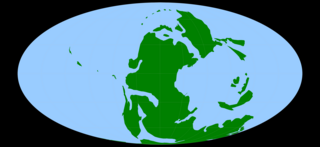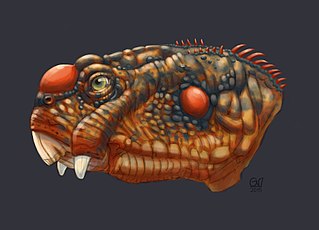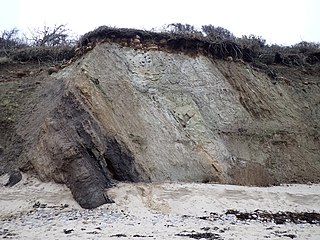
The Permian is a geologic period and stratigraphic system which spans 47 million years from the end of the Carboniferous Period 298.9 million years ago (Mya), to the beginning of the Triassic Period 251.902 Mya. It is the last period of the Paleozoic Era; the following Triassic Period belongs to the Mesozoic Era. The concept of the Permian was introduced in 1841 by geologist Sir Roderick Murchison, who named it after the region of Perm in Russia.

Approximately 251.9 million years ago, the Permian–Triassicextinction event forms the boundary between the Permian and Triassic geologic periods, and with them the Paleozoic and Mesozoic eras. It is the Earth's most severe known extinction event, with the extinction of 57% of biological families, 83% of genera, 81% of marine species and 70% of terrestrial vertebrate species. It is also the greatest known mass extinction of insects. It is the greatest of the "Big Five" mass extinctions of the Phanerozoic. There is evidence for one to three distinct pulses, or phases, of extinction.

The Triassic is a geologic period and system which spans 50.5 million years from the end of the Permian Period 251.902 million years ago (Mya), to the beginning of the Jurassic Period 201.4 Mya. The Triassic is the first and shortest period of the Mesozoic Era. Both the start and end of the period are marked by major extinction events. The Triassic Period is subdivided into three epochs: Early Triassic, Middle Triassic and Late Triassic.

The Early Triassic is the first of three epochs of the Triassic Period of the geologic timescale. It spans the time between 251.9 Ma and 247.2 Ma. Rocks from this epoch are collectively known as the Lower Triassic Series, which is a unit in chronostratigraphy. The Early Triassic is the oldest epoch of the Mesozoic Era. It is preceded by the Lopingian Epoch and followed by the Middle Triassic Epoch. The Early Triassic is divided into the Induan and Olenekian ages. The Induan is subdivided into the Griesbachian and Dienerian subages and the Olenekian is subdivided into the Smithian and Spathian subages.

In the geologic timescale, the Olenekian is an age in the Early Triassic epoch; in chronostratigraphy, it is a stage in the Lower Triassic series. It spans the time between 251.2 Ma and 247.2 Ma. The Olenekian is sometimes divided into the Smithian and the Spathian subages or substages. The Olenekian follows the Induan and is followed by the Anisian.
The Late Triassic is the third and final epoch of the Triassic Period in the geologic time scale, spanning the time between 237 Ma and 201.4 Ma. It is preceded by the Middle Triassic Epoch and followed by the Early Jurassic Epoch. The corresponding series of rock beds is known as the Upper Triassic. The Late Triassic is divided into the Carnian, Norian and Rhaetian ages.

The Induan is the first age of the Early Triassic epoch in the geologic timescale, or the lowest stage of the Lower Triassic series in chronostratigraphy. It spans the time between 251.9 Ma and 251.2 Ma. The Induan is sometimes divided into the Griesbachian and the Dienerian subages or substages. The Induan is preceded by the Changhsingian and is followed by the Olenekian.

The Daptocephalus Assemblage Zone is a tetrapod assemblage zone or biozone found in the Adelaide Subgroup of the Beaufort Group, a majorly fossiliferous and geologically important geological Group of the Karoo Supergroup in South Africa. This biozone has outcrops located in the upper Teekloof Formation west of 24°E, the majority of the Balfour Formation east of 24°E, and the Normandien Formation in the north. It has numerous localities which are spread out from Colesberg in the Northern Cape, Graaff-Reniet to Mthatha in the Eastern Cape, and from Bloemfontein to Harrismith in the Free State. The Daptocephalus Assemblage Zone is one of eight biozones found in the Beaufort Group and is considered Late Permian (Lopingian) in age. Its contact with the overlying Lystrosaurus Assemblage Zone marks the Permian-Triassic boundary.

The Lystrosaurus Assemblage Zone is a tetrapod assemblage zone or biozone which correlates to the upper Adelaide and lower Tarkastad Subgroups of the Beaufort Group, a fossiliferous and geologically important geological Group of the Karoo Supergroup in South Africa. This biozone has outcrops in the south central Eastern Cape and in the southern and northeastern Free State. The Lystrosaurus Assemblage Zone is one of eight biozones found in the Beaufort Group, and is considered to be Early Triassic in age.

The Ecca Group is the second of the main subdivisions of the Karoo Supergroup of geological strata in southern Africa. It mainly follows conformably after the Dwyka Group in some sections, but in some localities overlying unconformably over much older basement rocks. It underlies the Beaufort Group in all known outcrops and exposures. Based on stratigraphic position, lithostratigraphic correlation, palynological analyses, and other means of geological dating, the Ecca Group ranges between Early to earliest Middle Permian in age.

Skolithos is a common trace fossil ichnogenus that is, or was originally, an approximately vertical cylindrical burrow with a distinct lining. It was produced globally by a variety of organisms, mostly in shallow marine environments, and appears as linear features in sedimentary rocks.

The Elliot Formation is a geological formation and forms part of the Stormberg Group, the uppermost geological group that comprises the greater Karoo Supergroup. Outcrops of the Elliot Formation have been found in the northern Eastern Cape, southern Free State, and in the eastern KwaZulu-Natal provinces of South Africa. Outcrops and exposures are also found in several localities in Lesotho such as Qacha's Neck, Hill Top, Quthing, and near the capital, Maseru. The Elliot Formation is further divided into the lower (LEF) and upper (UEF) Elliot formations to differentiate significant sedimentological differences between these layers. The LEF is dominantly Late Triassic (Norian-Hettangian) in age while the UEF is mainly Early Jurassic (Sinemurian-Pliensbachian) and is tentatively regarded to preserve a continental record of the Triassic-Jurassic boundary in southern Africa. This geological formation is named after the town of Elliot in the Eastern Cape, and its stratotype locality is located on the Barkly Pass, 9 km north of the town.

The Stormberg Group is one of the four geological groups that comprises the Karoo Supergroup in South Africa. It is the uppermost geological group representing the final phase of preserved sedimentation of the Karoo Basin. The Stormberg Group rocks are considered to range between Lower Triassic (Olenekian) to Lower Jurassic (Pliensbachian) in age. These estimates are based on means of geological dating including stratigraphic position, lithostratigraphic and biostratigraphic correlations, and palynological analyses.
The Vikinghøgda Formation is a geologic formation in Svalbard, Norway. It preserves fossils dating back to the Early Triassic (Griesbachian-Spathian) period. It is split into three members, from oldest to youngest: the Deltadalen Member (Induan), Lusitaniadalen Member (Smithian), and Vendomdalen Member (Spathian). The formation can be found in central Spitsbergen, southern Spitsbergen, as well as the smaller islands of Barentsøya and Edgeøya. The type locality is positioned in the vicinity of Vikinghøgda and Sticky Keep, two low peaks along the southeast edge of Sassendalen in Spitsbergen. The two upper members of the Vikinghøgda Formation were previously grouped together as the Sticky Keep Formation.

The Bokkeveld Group is the second of the three main subdivisions of the Cape Supergroup in South Africa. It overlies the Table Mountain Group and underlies the Witteberg Group. The Bokkeveld Group rocks are considered to range between Lower Devonian (Lochkovian) to Middle Devonian (Givetian) in age.
Paleontology or palaeontology is the study of prehistoric life forms on Earth through the examination of plant and animal fossils. This includes the study of body fossils, tracks (ichnites), burrows, cast-off parts, fossilised feces (coprolites), palynomorphs and chemical residues. Because humans have encountered fossils for millennia, paleontology has a long history both before and after becoming formalized as a science. This article records significant discoveries and events related to paleontology that occurred or were published in the year 2020.

The Sorthat Formation is a geologic formation on the island of Bornholm, Denmark and in the Rønne Graben in the Baltic Sea. It is of Latest Pliensbachian to Late Toarcian age. Plant fossils have been recovered from the formation, along with several traces of invertebrate animals. The Sorthat Formation is overlain by fluvial to lacustrine gravels, along with sands, clay and in some places coal beds that are part of the Aalenian-Bathonian Bagå Formation. Until 2003, the Sorthat Formation was included as the lowermost part of the Bagå Formation, recovering the latest Pliensbachian to lower Aalenian boundary. The Sorthat strata reflect a mostly marginally deltaic to marine unit. Large streams fluctuated to the east, where a large river system was established at the start of the Toarcian. In the northwest, local volcanism that started in the lower Pliensbachian extended along the North Sea, mostly from southern Sweden. At this time, the Central Skåne Volcanic Province and the Egersund Basin expelled most of their material, with influences on the local tectonics. The Egersund Basin has abundant fresh porphyritic nephelinite lavas and dykes of lower Jurassic age, with a composition nearly identical to those found in the clay pits. That indicates the transport of strata from the continental margin by large fluvial channels of the Sorthat and the connected Röddinge Formation that ended in the sea deposits of the Ciechocinek Formation green series.
The Xiaowa Formation is a Carnian-age geological formation found in southern China. It is a sequence of limestone and marls from the Carnian stage of the Triassic. Its lower section was previously known as the Wayao Formation or Wayao Member of the Falang Formation. In 2002, the Wayao Member was renamed and raised to the Xiaowa Formation to prevent confusion with an Eocene unit of the same name. Crinoids and marine reptiles are abundant in the Xiaowa Formation, forming a lagerstätte known as the Guanling biota. Ammonoids and conodonts found in the formation constrain its age to the early Carnian. Reptiles of the Guanling biota include ichthyosaurs, thalattosaurs, placodonts, and Odontochelys. Sedimentary events within this formation have been tied to the Carnian Pluvial Event.
Schizophoria is an extinct genus of brachiopod belonging to the superfamily Enteletoidea. Specimens have been found in Devonian through Permian beds in North America, Australia, central and southeast Asia, and eastern Europe.
The Timezgadiouine Formation, sometimes spelled as the Timesgadiouine Formation, is a Triassic geological formation in the Argana Basin of Morocco. It is a succession of red bed sediments spanning from the Olenekian to at least the Carnian, encompassing members T3 to T5 of the Argana Group. It is preceded by the Permian Ikakern Formation and succeeded by the Late Triassic Bigoudine Formation.















